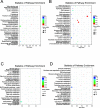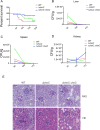Functional, transcriptomic, and lipidomic studies of the choC gene encoding a phospholipid methyltransferase in Aspergillus fumigatus
- PMID: 38009944
- PMCID: PMC10783049
- DOI: 10.1128/spectrum.02168-23
Functional, transcriptomic, and lipidomic studies of the choC gene encoding a phospholipid methyltransferase in Aspergillus fumigatus
Abstract
This study explored the phospholipid metabolic pathway in A. fumigatus and its relationship with fungal growth, metabolism, and pathogenicity. ChoC, based on its critical roles in many aspects of the fungus and relatively conserved characteristics in filamentous fungi with low similarity with mammalian ones, can be a novel target of new antifungal drugs.
Keywords: Aspergillus fumigatus; ChoC; lipidomics; phosphatidylcholines; transcriptomics.
Conflict of interest statement
The authors declare no conflict of interest.
Figures






Similar articles
-
The choC gene encoding a putative phospholipid methyltransferase is essential for growth and development in Aspergillus nidulans.Curr Genet. 2010 Jun;56(3):283-96. doi: 10.1007/s00294-010-0300-8. Epub 2010 Apr 9. Curr Genet. 2010. PMID: 20379720
-
Roles of phospholipid methyltransferases in pycnidia development, stress tolerance and secondary metabolism in the taxol-producing fungus Pestalotiopsis microspore.Microbiol Res. 2018 May;210:33-42. doi: 10.1016/j.micres.2018.03.001. Epub 2018 Mar 8. Microbiol Res. 2018. PMID: 29625656
-
The Putative APSES Transcription Factor RgdA Governs Growth, Development, Toxigenesis, and Virulence in Aspergillus fumigatus.mSphere. 2020 Nov 11;5(6):e00998-20. doi: 10.1128/mSphere.00998-20. mSphere. 2020. PMID: 33177217 Free PMC article.
-
Developmental regulators in Aspergillus fumigatus.J Microbiol. 2016 Mar;54(3):223-31. doi: 10.1007/s12275-016-5619-5. Epub 2016 Feb 27. J Microbiol. 2016. PMID: 26920882 Review.
-
The ergosterol biosynthesis pathway, transporter genes, and azole resistance in Aspergillus fumigatus.Med Mycol. 2005 May;43 Suppl 1:S313-9. doi: 10.1080/13693780400029114. Med Mycol. 2005. PMID: 16110826 Review.
Cited by
-
Molecular Mechanisms of Pathogenic Fungal Virulence Regulation by Cell Membrane Phospholipids.J Fungi (Basel). 2025 Mar 26;11(4):256. doi: 10.3390/jof11040256. J Fungi (Basel). 2025. PMID: 40278077 Free PMC article. Review.
-
The authentication of Yanchi tan lamb based on lipidomic combined with particle swarm optimization-back propagation neural network.Food Chem X. 2024 Nov 22;24:102031. doi: 10.1016/j.fochx.2024.102031. eCollection 2024 Dec 30. Food Chem X. 2024. PMID: 39659677 Free PMC article.
References
-
- Abad A, Fernández-Molina JV, Bikandi J, Ramírez A, Margareto J, Sendino J, Hernando FL, Pontón J, Garaizar J, Rementeria A. 2010. What makes Aspergillus fumigatus a successful pathogen? Genes and molecules involved in invasive aspergillosis. Rev Iberoam Micol 27:155–182. doi:10.1016/j.riam.2010.10.003 - DOI - PubMed
MeSH terms
Substances
Grants and funding
LinkOut - more resources
Full Text Sources

